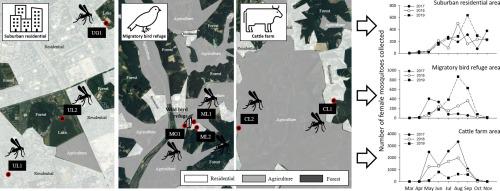Journal of Asia-Pacific Entomology ( IF 1.1 ) Pub Date : 2021-03-25 , DOI: 10.1016/j.aspen.2021.03.011 Minhyung Jung , Soowan Kim , Doo-Hyung Lee

|
Population dynamics and species composition of mosquitoes were monitored in a suburban residential area and rural areas, including a migratory bird refuge area and a cattle farm area, from 2017 to 2019. Mosquitoes were collected every two weeks using one BG sentinel trap and two black-light traps in a suburban residential area and a migratory bird refuge area, and one black-light trap in a cattle farm area from March to November. From the surveillance, a total of 13,267, 9,697 and 6,688 mosquitoes were collected in 2017, 2018, and 2019, respectively. The peak of the mosquito population was observed in August and September in both the suburban residential area and rural areas. In general, Culex pipiens pallens was the dominant species in the suburban residential area, whereas Aedes vexans nipponii and Anopheles spp. were the most dominant in the rural areas. Collected mosquitoes were pooled into groups for each collection site and species to investigate flavivirus harboring. Three pools were positive for Japanese encephalitis virus type V, one pool was positive for Chaoyang virus, and six pools were positive for Culex flavi virus from the 731 pools tested. When total numbers of collected mosquitoes were further analyzed by linear regression analysis for their interaction with ambient temperature and relative humidity, the number of mosquitoes were significantly affected by the ambient temperature. In contrast, relative humidity was significantly affecting the total number of mosquitoes only for the migratory bird refuge area.
中文翻译:

韩国京畿道蚊子的种群动态及其对疾病的危害
自2017年至2019年,在郊区居民区和农村地区(包括候鸟避难区和养牛场)对蚊子的种群动态和物种组成进行了监测。每两周使用一个BG前哨诱捕器和两个黑色捕蝇器收集蚊子。 3月至11月,在郊区居民区和候鸟庇护区设置了照明灯诱集装置,在养牛场的区域安装了一个黑灯诱集装置。通过监视,在2017年,2018年和2019年分别收集了13267、9697和6688蚊子。在郊区和农村地区,八月和九月都发现了蚊子的高峰。一般而言,淡色库蚊是郊区居民区的主要物种,而日本伊蚊(Aedes vexans nipponii)和按蚊属。是农村地区最主要的地区。对于每个收集地点和物种,将收集的蚊子分成几组,以调查黄病毒的携带情况。来自731个测试库的3个库对日本V型脑炎病毒呈阳性反应,一个库对朝阳病毒呈阳性,对库克斯黄病毒则有6个库对阳性。当通过线性回归分析进一步分析收集的蚊子总数与环境温度和相对湿度的相互作用时,环境温度显着影响了蚊子的数量。相反,仅在候鸟庇护区,相对湿度会显着影响蚊子的总数。











































 京公网安备 11010802027423号
京公网安备 11010802027423号